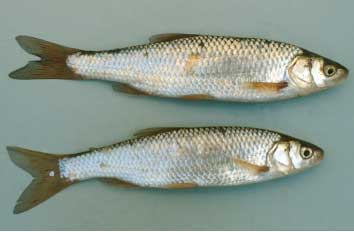
Another serpentine fish is the eel (Anguilla anguilla) which used to go up the great rivers like the Piave as far as the mountain streams and torrents. Today it has almost disappeared, mostly because of the man-made barriers which block its course. The stickleback (Gasterosteus aculeatus) is another interesting fish which lives in the lake of Alleghe, the only local fish to construct a circular nest, made of bits of plants glued together with sticky threads from its body, which it then defends aggressively against intruders. Its name is derived from the 3 individual spikes on its back. Finally the pike (Esox lucius), the great predator of lakes and slow moving rivers, recognisable by its torpedo shape, flattened head and duck-like mouth. It can be over a metre long and more than 20 kilos in weight.
The Morphology of Fish
In the area round Belluno only fresh-water fish live. They are all vertebrates with a bone skeleton and jaws, except for the lamprey with its cartilage skeleton and circular mouth like a sucker. Its skin is covered with scales and the silver sheen of the flanks and abdomen comes from the crystals of “guanina”, while its colour depends on individual cells containing various pigments called chromatophores.
Its body is kept in balance by two pairs of belly fins, which correspond to the limbs of more advanced animals (rib belt and pelvic belt).
While the tail and lower trunk give direction and propulsion, the asymmetrical dorsal and anal fins give stability. Its hydrodynamic form and highly developed muscles enable it to move - sometimes extremely rapidly - in water, which is much denser than air. One of its internal organs is a special sac - the air bladder - containing a mixture of gasses, probably with a hydrostatic function.
Fish breathe through gills, which are supported by four arches. In the gills the exchange of gas between blood and water takes place, i.e. oxygen is absorbed and carbon dioxide given off.
The different forms of mouth, lips and teeth correspond to the different feeding habits.
Their sense of smell is highly developed, their sight relatively reduced and their tactile sense derives from nerve terminals linked to sensory cells along the body.
The local fish are oviparous and, except for the trout and whitefish which reproduce during winter, lay eggs during the summer.